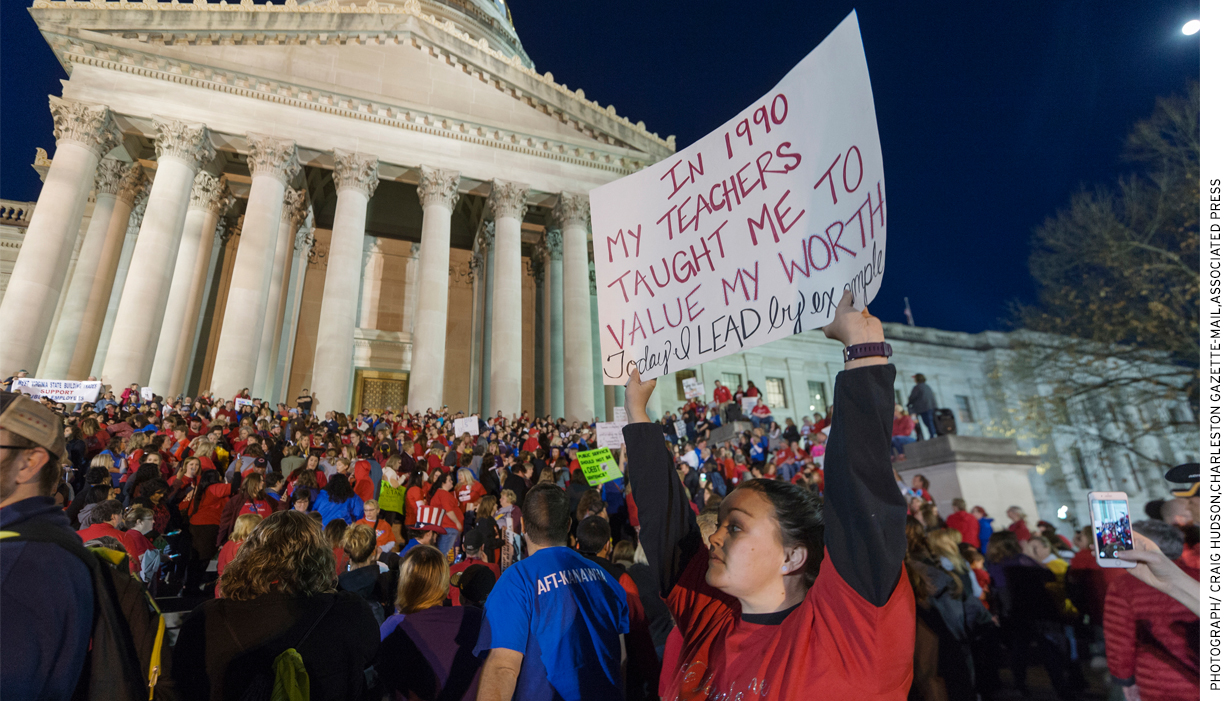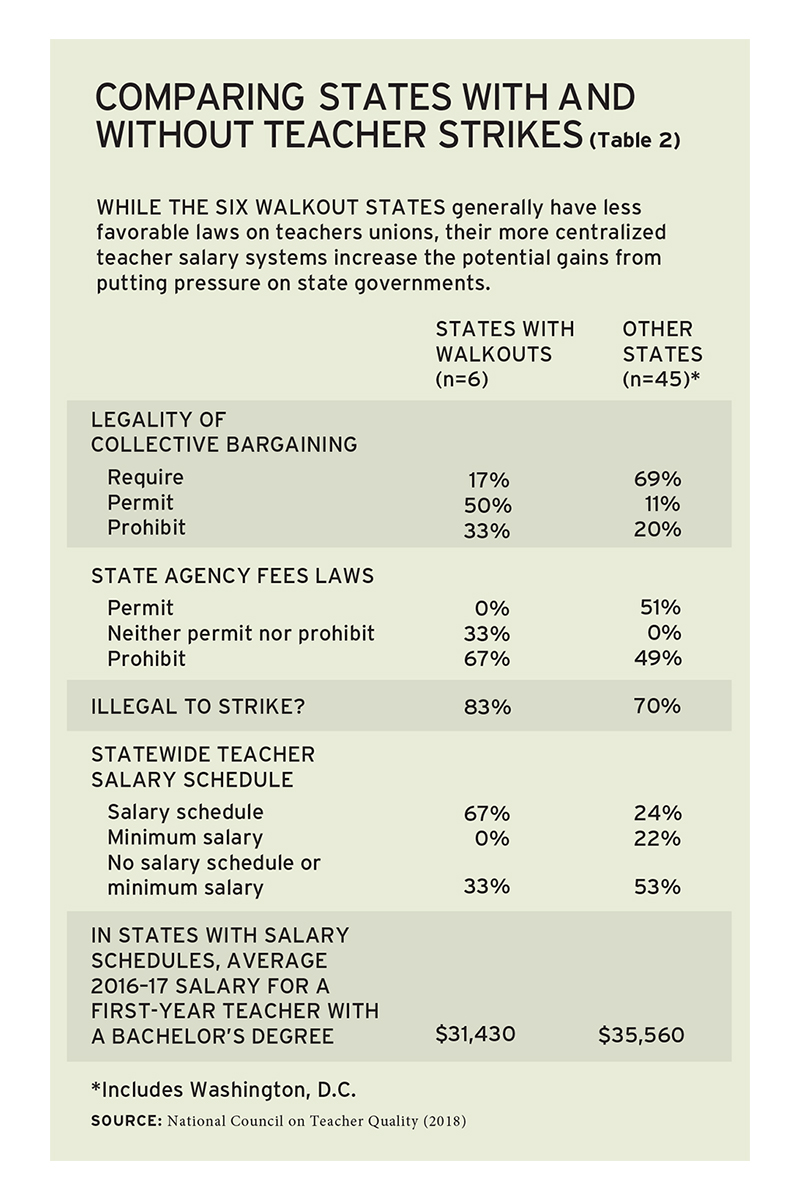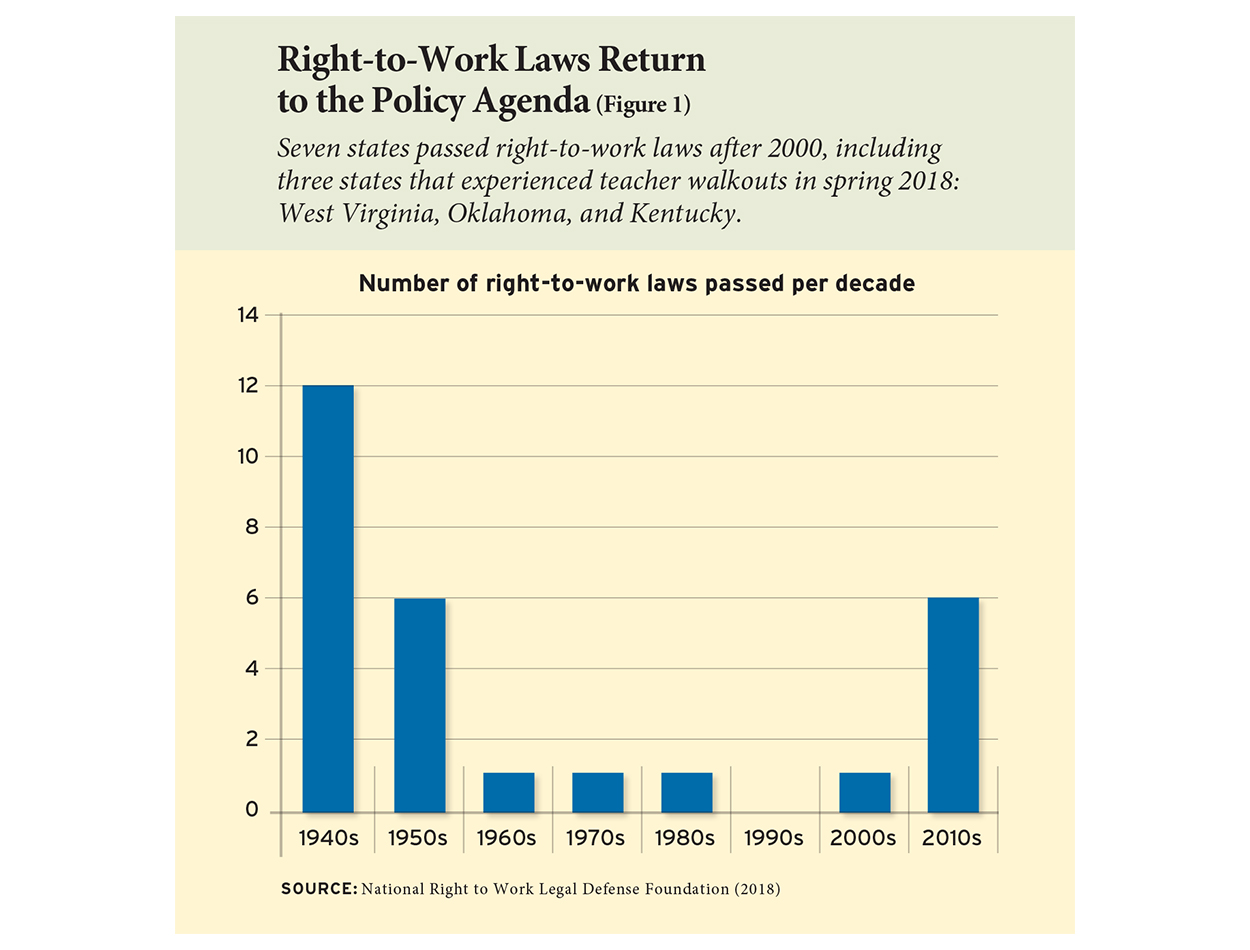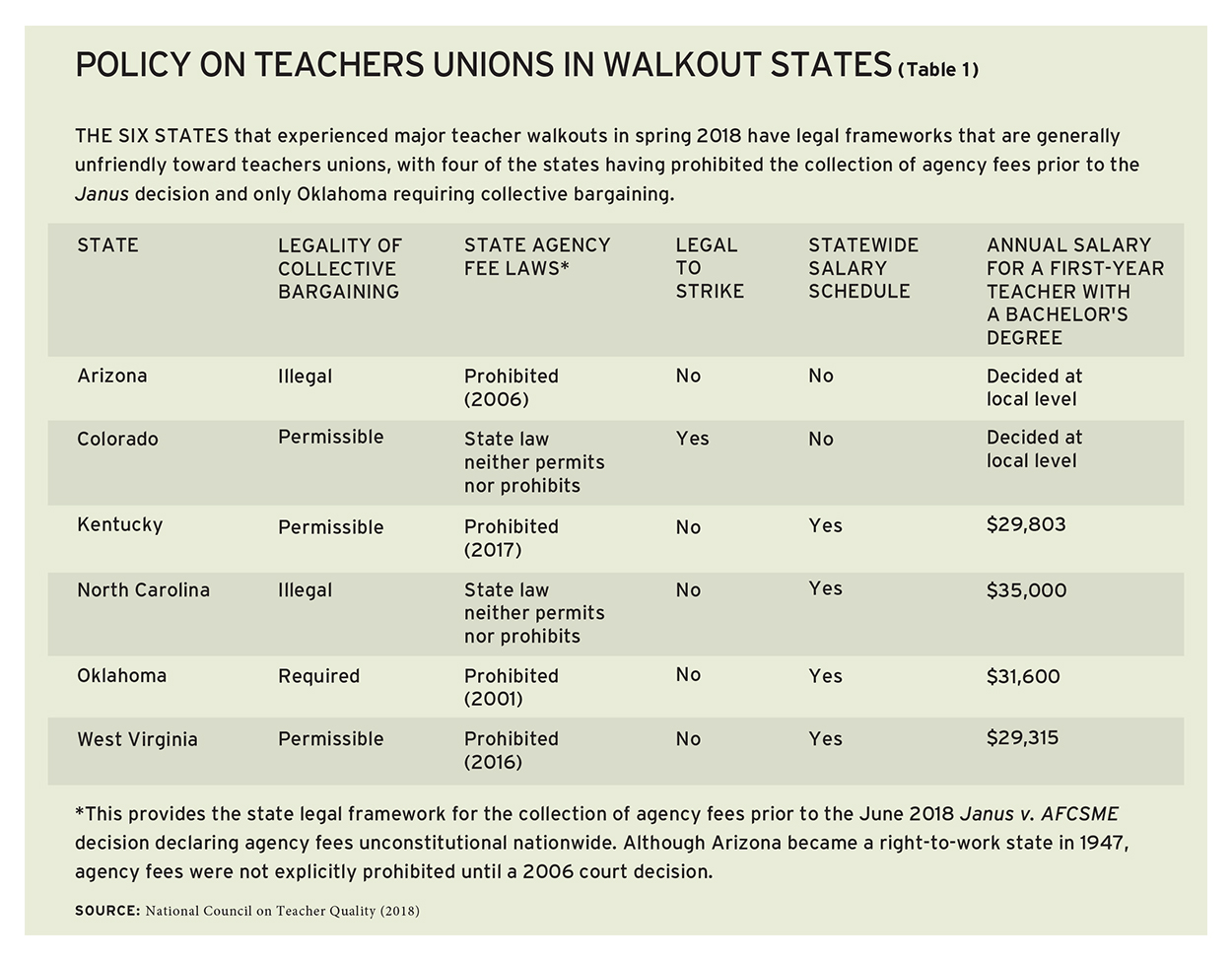 Once considered king of the ring, teachers unions have spent most of this century counterpunching and playing defense.
Once considered king of the ring, teachers unions have spent most of this century counterpunching and playing defense.
Political scientist Terry Moe has argued that teachers unions are by far “the most powerful groups in the politics of education.” But his assessment is based largely on unions’ advantages in local districts, where typically low voter turnout allows a mobilized and focused group like the teachers union to elect sympathetic school boards. Beginning in the 1980s, the growing roles of state and federal governments in public education took many decisions out of the unions’ favored venue. To be sure, teachers unions also have muscular presence in some states, but in others, especially in the South and Southwest, the unions have held little power in recent decades, and the growing dominance of conservative Republicans in state legislatures and statehouses was creating a hostile environment even before the U.S. Supreme Court landed its Janus jab to the jaw.
It’s ironic, then, that some of the most dramatic recent signs of teacher voice and vitality have occurred at the state level—and in places where one might expect the law, politics, and culture to be inhospitable. The Janus v. AFCSME decision takes to the national level a legal assault on unions manifest most recently in the states, through the passage of right-to-work (RTW) laws. These laws prohibit unions from collecting “agency fees” or “fair share fees” from non-members to help support the collective bargaining done on their behalf. Although most states that passed RTW laws did so in the 1940s and ’50s, a new wave of such legislation arose in the 2000s, beginning in Oklahoma in 2001 (see Figure 1). Indeed, seven states adopted new RTW laws after 2000, including West Virginia, Oklahoma, and Kentucky, all three of which experienced large-scale teacher walkouts in the spring of 2018. In Janus, the Supreme Court declared agency fees unconstitutional for public-employee unions.
It’s possible that the recent flurry of state-focused teacher protests will prove to be a short-lived spasm of resistance that doesn’t stem the steady and continuing decline of unions. But a number of factors hint at a different narrative, in which the unions adjust their strategies in ways that not only minimize damage but provide them with new energy, sense of purpose, and a stronger set of alliances. In this article we speculate about what the recent teacher actions might augur in terms of teachers-union strategies in the post-Janus era.
States as the Venue of Choice?
Do the recent strikes signal a broader shift to state-level activism? They might, but a careful look at the policy environments where the actions occurred suggests that these states are atypical, given their labor policy and state centralization. Table 1 describes the political and legal contexts for the six recent statewide teacher walkouts, and Table 2 compares these states to the rest of the country. The information presented shows that states experiencing walkouts have legal frameworks that are less friendly toward teachers unions. Only one of the six states with high-profile statewide strikes require collective bargaining, whereas more than two thirds of other states do. None of the states with strikes affirmatively permitted the collection of agency fees prior to Janus, whereas more than half of other states did. These six states have also traditionally had greater centralization of decisionmaking at the state level, which makes state-targeted activism a more rational choice. For example, two thirds of the states with walkouts had statewide teacher-salary schedules establishing minimum salaries for teachers based on certain qualifications, whereas only one fourth of the states not experiencing walkouts set salary schedules. This centralization may even help to explain why some of these walkouts had the support of local school-district management.
 Americans love an underdog, and one reason these recent actions struck a popular chord is precisely that they emerged against all odds. News coverage was highly sympathetic, emphasizing that teachers in these states were working multiple jobs, receiving some of the lowest pay in the nation, bearing the brunt of budget reductions, and suffering financially as a result of cuts from five- to four-day school weeks. Often, the coverage depicted selfless teachers standing up for the sake of the kids. “I came to the Capitol not just for myself, not just for a raise, but for my students,” one teacher was quoted as saying. Another was described as using stickers to adorn her strike poster with the names of all her students: “I feel like I have to have a voice for these guys.” Notably, public-opinion surveys have shown robust public support for the teachers’ actions. The 2018 Education Next poll revealed a large jump in support for increasing teacher pay, particularly in states that experienced walkouts, and a strong majority favoring teachers’ right to strike (see “Public Support Climbs for Teacher Pay, School Expenditures, Charter Schools, and Universal Vouchers,” features, Winter 2019).
Americans love an underdog, and one reason these recent actions struck a popular chord is precisely that they emerged against all odds. News coverage was highly sympathetic, emphasizing that teachers in these states were working multiple jobs, receiving some of the lowest pay in the nation, bearing the brunt of budget reductions, and suffering financially as a result of cuts from five- to four-day school weeks. Often, the coverage depicted selfless teachers standing up for the sake of the kids. “I came to the Capitol not just for myself, not just for a raise, but for my students,” one teacher was quoted as saying. Another was described as using stickers to adorn her strike poster with the names of all her students: “I feel like I have to have a voice for these guys.” Notably, public-opinion surveys have shown robust public support for the teachers’ actions. The 2018 Education Next poll revealed a large jump in support for increasing teacher pay, particularly in states that experienced walkouts, and a strong majority favoring teachers’ right to strike (see “Public Support Climbs for Teacher Pay, School Expenditures, Charter Schools, and Universal Vouchers,” features, Winter 2019).
What are the implications of the walkouts for other states? In examining this question, there are at least two other factors worth considering. Both come into better focus when we compare the recent state actions with the Chicago teachers’ strike of 2012.
First, national unions may have played supporting roles in the recent actions, but what was prominent was the voice of teachers, not the voice of union leaders. Media and pundit accounts of the seven-day Chicago strike gave prominence to the Chicago Teachers Union (CTU). With the union in the foreground, it was easy to paint the action as the work of an interest group defending members’ pocketbooks at the expense of students and their families. Whether unions are able and willing to adopt a more behind-the-scenes role in states where they have a structured presence is one question still to be answered.
Second, there is a racial dimension that may be important. Although the nation’s K–12 teacher workforce is still predominantly white (82 percent in 2012), the proportion who are teachers of color has increased, from 13 percent in 1988 to 18 percent in 2012. This trend is especially strong in inner cities: in 2014, 25 percent of inner-city teachers and 28 percent of new teachers were black or Hispanic, compared to 17 percent and 21 percent nationwide. Karen Lewis, the high-profile president of the CTU until she stepped down recently for health reasons, is black, and only half of Chicago Public Schools teachers and just over one third of the staff identify as white. In the large central-city school systems where teachers unions are most active and visible, the composition of the teaching force can lead suburban and rural voters, and their elected representatives, to implicitly associate union politics with minority politics, and a variety of studies have shown that policies associated with minorities tend to be less generous and more vulnerable to political headwinds. Although it may be uncomfortable to discuss, the faces shown in the news during the walkouts were predominantly those of white teachers, and that portrayal may have made the protesters more sympathetic to audiences outside large cities, where residents do not tend to view systemic racism as an issue. Roughly half of suburban whites and 6 out of 10 rural whites reject the notion that whites have advantages that black Americans do not.
To the extent that race comes into play, teachers unions in large cities may face a tougher challenge winning over broad public support at the state level, where opponents can more easily mobilize racial resentments against urban teachers unions.
Winning Allies versus Rallying the Base
Just as political parties struggle to find a balance between wooing undecideds and appealing to their base, so too must teachers unions consider how much to focus on winning allies versus providing what their members expect and demand from them. The Janus decision complicates this challenge in at least two ways.
One has to do with relations with fellow interest groups such as other unions, civil- and immigrant-rights organizations, and the array of nonprofit and advocacy organizations that focus on the needs of children and families. Although these organizations share many values, they can differ on how they prioritize issues and where they choose to invest their money and political muscle. If Janus, as predicted, leaves teachers unions with lighter coffers, they may need external allies more than ever, but cementing those alliances may sometimes mean de-emphasizing the school- and teacher-specific issues that their members value highly.
The second complication has to do with likely changes in the composition of union ranks as teachers begin to drop their membership now that they are no longer required to pay agency fees if they leave. It is a safe assumption that today’s non-members will continue to opt out, but no one knows how many current members will quit. One can venture to say, however, that those who remain in the union will, on balance, be different from those who leave, in terms of how they view union activity. The teachers who are motivated primarily by their own personal well-being—salary hikes and attractive working conditions—might be expected to leave. The remaining core of members, though diminished, will therefore likely comprise those with deeper allegiance to the collective goals that unions have stood for.
But unions have stood for two different kinds of collective goals: education-specific ones that relate to improving the education system and the status of teachers generally, and those relating to general social betterment through strong government action. If their loyalty and fervor center on education-specific collective goals, core union members might consider their leaders’ alliance-building efforts to be a distraction from their primary concerns. On the other hand, if the loyalty and fervor of the remaining members are stoked more by goals relating to societal betterment through a muscular public sector, then tensions between union leaders and the rank and file could diminish with the exit of members who were ambivalent or reluctant enlistees to that cause.
The recent teacher actions may shed light here. Although they took place before the Janus decision, they happened in states where the legal status of unions and union membership resembles that which Janus promises to expand nationwide. Teachers in those states were not forced members of unions, but in spite of that—or perhaps because of it—they chose to link hands in a collective enterprise focused more obviously on system improvement than on personal benefit, and this helped account for the greater willingness of non-parents, politicians, and the media to treat them more as heroes than pocket-lining villains. That’s a reminder that a smaller but more collectively motivated core of members may facilitate strong actions, and that’s good news for the teachers unions.
On the other hand, the recent teacher walkouts were largely detached from broader social issues like poverty, social programs, health care, and inequality, and were primarily focused on the distribution of material resources—both to teachers and to schools in general. In culturally conservative states, keeping a focus on education, as these teachers did, could help teachers avoid ideological and partisan tripwires that could mobilize a backlash against their activism. However, that option may not be available in more liberal states and on the national political battlefield, where the need to work with allies and to fully motivate their more socially conscious members will inevitably draw teacher activists into more controversial positions.
Similarly, where education funding has been obviously and embarrassingly paltry compared to that of other states, teachers and their unions may find it easier to gain public support for increasing school spending, whereas teachers unions in high-spending states like New York may experience more pushback from third parties that hope to keep taxes low or consider current education spending levels to be adequate.
The bottom line is that teachers unions will have tactical options, even in unsupportive legal environments. And to the extent the action is being driven to the state level, the weighing of options and their likely success will vary from place to place and perhaps over time. But hyper-focus on how individual teachers will weigh the impacts on their pocketbooks can overlook the lessons from recent state walkouts: teachers, their allies, and the general public take positions also based on purposive goals and perceptions of what is fair and just. Money is an issue, but so are motivating hearts and shaping perceptions. By convincingly embracing a broader agenda, teachers unions may convert recent political and judicial setbacks into a more energized core and more extensive constituency, even if their formal membership shrinks.
This is part of a forum, “After the Teacher Walkouts.” For an alternate take, see “Statewide Strikes Are a Shot across the Bow,” by Sarah F. Anzia.
This article appeared in the Winter 2019 issue of Education Next. Suggested citation format:
Henig, J.R., Lyon, M.A., and Anzia, S.F. (2019). After the Teacher Walkouts: Will unions shift their focus to the statehouse? Education Next, 19(1), 52-60.




